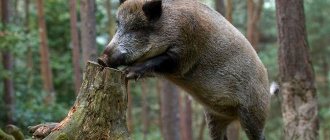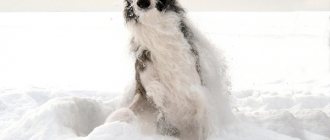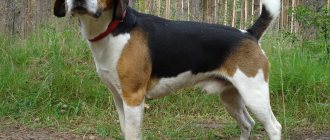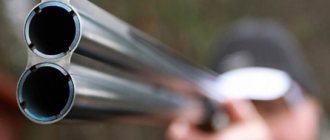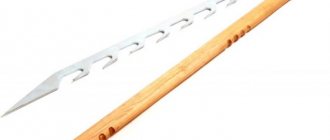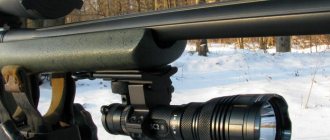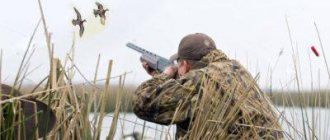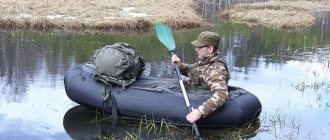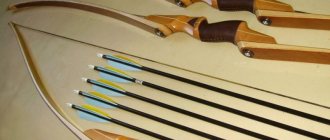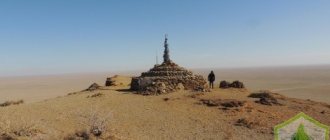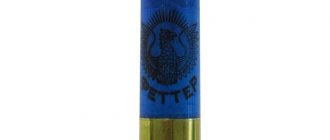History of the Estonian Hound breed
Hound dogs began to be systematically bred in Estonia in the middle of the 18th century. Initially, Russian and Polish hounds were used for selection; at the end of the century before last, hunting dogs from England were imported to the Baltic states. By the 1920s, local hunting dogs became known as Russian-Polish or Russian-English hounds.
Estonian hound
In 1934, new hunting rules were adopted in Estonia, since in the hunting grounds, the territory of which was very small, the number of animals had catastrophically decreased, and the roe deer population was on the verge of extinction. According to the new rules, hunting with dogs was allowed only for small and medium-sized animals, and the height of hounds was limited to 45 cm at the withers. From that time on, work began on the creation of a short hound, which was supposed to retain all the working qualities inherent in a hunting dog. Work on developing a new breed lasted more than 20 years, and it was headed and coordinated by the Estonian dog handler Sergei Smelkov, who rightfully took the pedestal of the creator of the Estonian hound breed.
Initially, the shortest of the local hounds were selected for selection and crossed with the short English hare hound - the beagle. The technique was thoroughly thought out, because not only such a sign of the future breed as short stature was fixed. The English Beagle was also selected for its stout legs, dense and strong paws. These qualities are ideal for Estonian winters with little snow, when hunting trails here often become hard as stone and completely unsuitable for hunting with light-footed dogs. However, such shortcomings of beagles as a cacophonous, rough and muffled voice, the late formation of hunting instincts, and insufficient paratism (the speed with which a dog pursues an animal) prompted Smelkov to also involve the Swiss hound in the creation of a new breed. Although it does not have a sufficiently strong paw, it nevertheless attracted the attention of breeders due to its small stature, excellent viscosity, musical ringing voice and the ability to take up vigorous activity already in the first year of life.
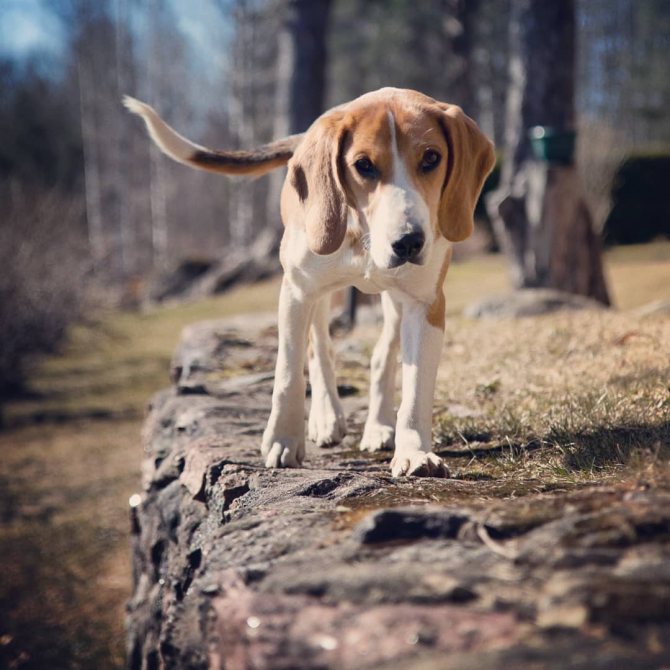
Estonian hound on a walk
It is worth saying that Finnish hounds, English fox hounds, and Russian hounds were also involved in breeding work. By crossing them with standard local hounds, Smelkov intended to separately breed fairly large hunting dogs (52-60 cm). Actually, back in the 40s, the future Estonian hound breed was very diverse, and manifestations of this feature are to some extent sometimes recorded in the animal’s exterior to this day.
In 1947, the USSR Ministry of National Economy took the initiative to oblige each of the fifteen republics to be represented by its own breed of dog. By this time, there were 800-900 hounds in Estonia belonging to the Estonian-English-Swiss breeding line that came out on top. In 1954, 48 individuals typical of this line, tested in hare and fox hunting, passed a specialized commission and were recognized by the USSR Ministry of Agriculture as a separate breed, called the Estonian hound. In 1959, a commission of the USSR Kennel Council approved the breed standard. By the beginning of the eighties, there were 1,750 purebred Estonian hounds in the Soviet Union.
Today, representatives of the original Estonian breed are found mainly in the Baltic countries, Finland, and Russia. Despite the efforts of local dog handlers, the Fédération Cynologique Internationale (FCI) still does not want to recognize the breed. Its standard, approved in 1959, is still valid today, but in 2007 minor changes were made to it regarding the color of the dog.
Main signs and characteristics of hound breeds
This article will consider only the most basic characteristics of breeds in their necessary qualities for hunting. The subtleties of separating different types of hounds are not so significant in hunting practice, although cynologists of hunting societies always try to adhere to the pan-European standard, which helps to maintain the purity, and therefore the remarkable working qualities of the dogs. The main characteristics of a hound: hanging ears, a body of medium massiveness and length with a fairly wide chest, a tucked belly and a straight back, a radish tail, i.e. tapering to the tip without feathering. Most hound dogs are short-haired.
- Ears do not play the main role in searching for animals, so hounds have closed ears that protect the hearing aid from damage. The same can be observed in hunting breeds for waterfowl and burrows. The hound’s main weapon is a subtle sense of smell and tirelessness in searching;
- namely the body, often close to the square type. The “knocked-down block” of this type of dog is an indicator of excellent physical shape. The tucked belly smoothly transitions to the groin without excessive retraction like a greyhound. The chest is wide enough, but not excessively. It is the average width of the body that makes it possible to withstand a strong opponent, while at the same time excessive width would be an obstacle to the speed characteristics of running. Of course, the pursuit speed of greyhounds is much higher; their narrow chest allows for excellent maneuvering while running, which is also inherent in a wolf. Hound breeds do not have the task of catching up with the animal, they only need to drive it out to the hunter. However, a meeting with a hunted animal can turn into a confrontation, which means that some of the fighting qualities must be preserved;
- The height of these dogs varies greatly among different breeds. Dachshund hounds, beagles, and basset hounds have short legs, which allows them to move well in dense thickets and penetrate shelters. Many types of European, English, French breeds, the Russian hound have a taller body and longer limbs. But in any case, the hound must have strong bones, the paw must be dense and elastic for good running. The position of the front shoulder blade is somewhat inclined, which in any hound gives it a slightly inclined silhouette. The hind leg forms an obtuse angle with the underbelly, the so-called “bow”. The body gains the well-known swiftness;
- The second most important quality, after physical form, is the voice. This is a unique quality of these dog breeds. A vyzhlovka or vyzhlovka must have a ringing, sonorous voice with a good timbre, “telling,” as hunters like to characterize it, i.e. heard from afar. In addition to the fact that this is one of the dog’s main tools in work, it is also, according to many fans, a decoration for hunting and communication with autumn nature, creating a certain flavor.
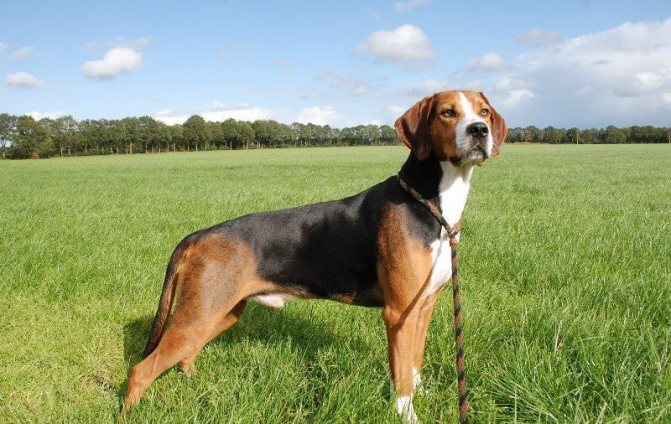
If the above characteristics and working qualities of a hound largely depend on the purity of the blood, they are inherited, which is a clear illustration of “why you should take a puppy only from purebred parents.” Other qualities of the dog, although they depend on the pedigree, are amenable to training and are brought to perfection with the help of education and training. Flair, tirelessness (tirelessness), viscosity (persistence), porosity (speed of the rut) are inherited. Obedience, loyalty (barking only at the right game), crawling (the ability to find an animal) are among the characteristics that are brought up.
Appearance of the Estonian hound
The Estonian Hound is a muscular dog of small size, lean type of constitution, with solid, strong bones. Her physique is proportional, the length of the body noticeably exceeds the height at the withers. Unlike the squat and downright stocky Beagle, with which the Estonian Hound is often confused, the latter exhibits elegant and graceful features.
Frame
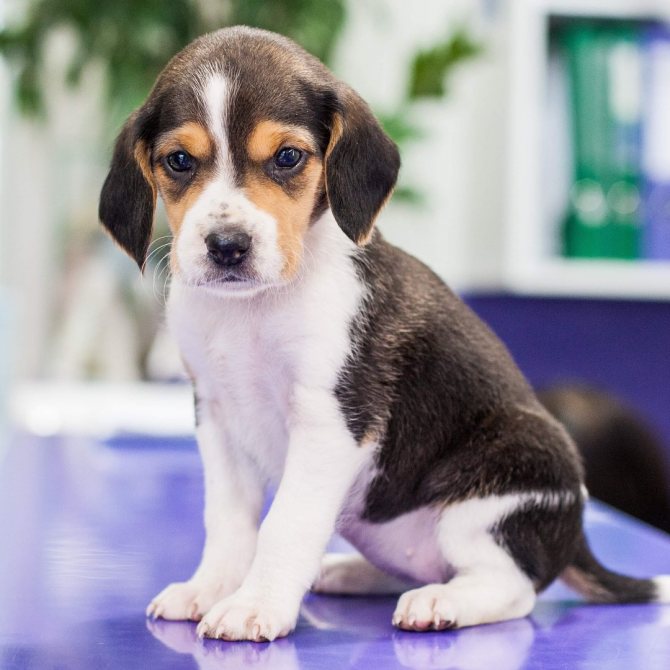
Estonian hound puppy
The line of the back is straight, with a slope from the withers to the sacrum. Both the back and croup are wide and muscular. The voluminous, elongated chest has an oval shape, it is lowered to the elbows and extends to a moderately tucked abdominal wall.
Head
The curved skull is moderately wide, the line of transition to the muzzle looks quite smooth, without a sharp break. The muzzle itself is elongated, straight, proportional to the skull. The brow ridges stand out clearly, but not overly. The nose is wide, fleshy, black in color, its intensity varies with different colors. Lips are dry, not drooping, totally pigmented.
Teeth and jaws
The teeth are white, large, there should be 42 of them. The bite is scissor-shaped, the upper incisors confidently cover the lower ones. As the dog ages, and the incisors wear down, the bite may become straight. The strong jaws of the Estonian Hound are well developed. The cheekbones are lean, without protrusion.
Eyes
The eyes of the Estonian hound are set slightly askew. Their color is dark brown.
Ears
The ears are quite thin, hanging close to the cheeks. Covered with short fur. Their base is located on the eye line. If you extend the ears towards the nose, they will reach approximately the middle of the muzzle. The tips of the ears are noticeably rounded.
Neck
The hound's rounded, muscular neck is of medium length. There are no folds on the skin in the neck area.
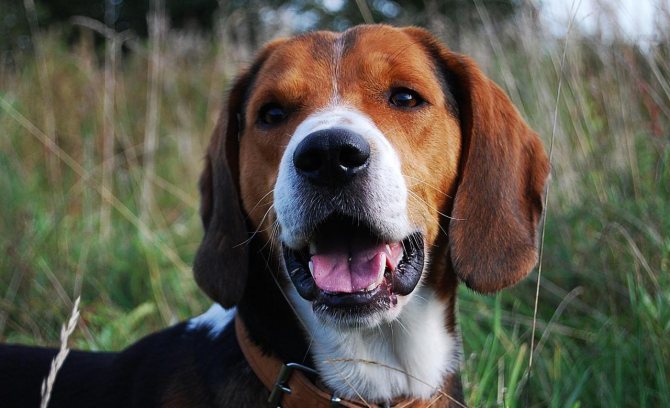
Estonian hound muzzle
Limbs
The forelimbs are lean, with well-developed muscles. From the front they look straight and parallel. Their length is approximately half the height of the animal at the withers.
The elbows are strong, close to the body, not protruding either inward or outward. Large, absolutely straight, proportional to the body, the forearms are of medium length. The pasterns are solid, strong, set almost vertically.
The hind limbs of the Estonian hound are powerful, bony, and muscular. From behind they look straight and parallel to each other. The angles of the joints appear clearly. The femurs and tibiae are almost identical in length. The knee joints are strong, with moderate angles. When the dog is in motion, they should not turn in or out. Strong metatarsus of medium length, set vertically.
The paws are arched, elliptical in shape, the toes are closely pressed to each other. The pads and claws directed towards the ground are large and dense.
Movement
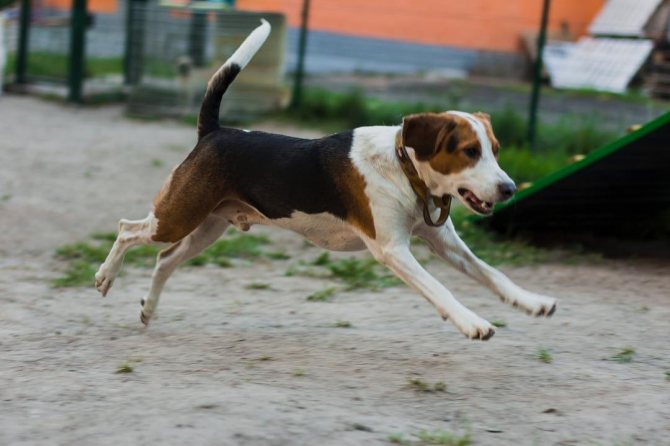
Running Estonian hound
The Estonian Hound moves freely, measuredly, plastically, rectilinearly, elastically. The push of the hind limbs is very powerful and confident.
Tail
Thick at the base, covered with thick hair, the tail gradually tapers to the tip, it has a saber shape, reaching the hock joint. When the Estonian Hound moves, the tail should not rise above the line of the back.
Wool
Short, straight, tough, even rough, shiny. The undercoat is very poorly developed.
Color
The characteristic color for the breed is black and piebald on a white background with so-called blush - markings whose color is close to red tan. We also accept brown-piebald color in blush, crimson-piebald, saddleback, looking like a blanket thrown over the back and sides of the dog. The size and shape of the marks may vary, and it is desirable for colors to have maximum intensity. White color should be present on the head, lower parts of the neck, chest, and abdomen. The Estonian Hound's legs and tail tip should be completely white.
Disadvantages of the breed
- Lightness or, on the contrary, heaviness of the dog’s constitution.
- High backside, excessively shortened or elongated torso.
- Too narrow or flat chest, barrel-shaped chest.
- Weak, sagging or hunchbacked back, excessively sloping croup.
- An expressively convex or flattened skull, a sharp or not at all noticeable transition from the forehead to the muzzle. Upturned or downturned muzzle, hooked nose.
- The nose, edges of the lips, and eyelids are not pigmented enough.
- Non-contact bite of incisors.
- Excessively small or bulging eyes, their light color.
- Shortened or excessively fleshy ears, elongated hair on them.
- The vertical position of the neck, the sagging of the skin on it.
- The tail is lowered below the hock joint by more than 3 cm. Short tail, curvature at its tip. Excessive length of hair on the tail, or, on the contrary, scanty coat.
- Elbows turned outwards, hocks. Excessively sloping pasterns, flat or elongated (hare) paws.
- Wavy fur. Excessively long or very short hair on the body, absolute absence of undercoat.
- Cowardice, excessive excitability, aggressiveness.
Photo of the Estonian hound
Personality of the Estonian Hound
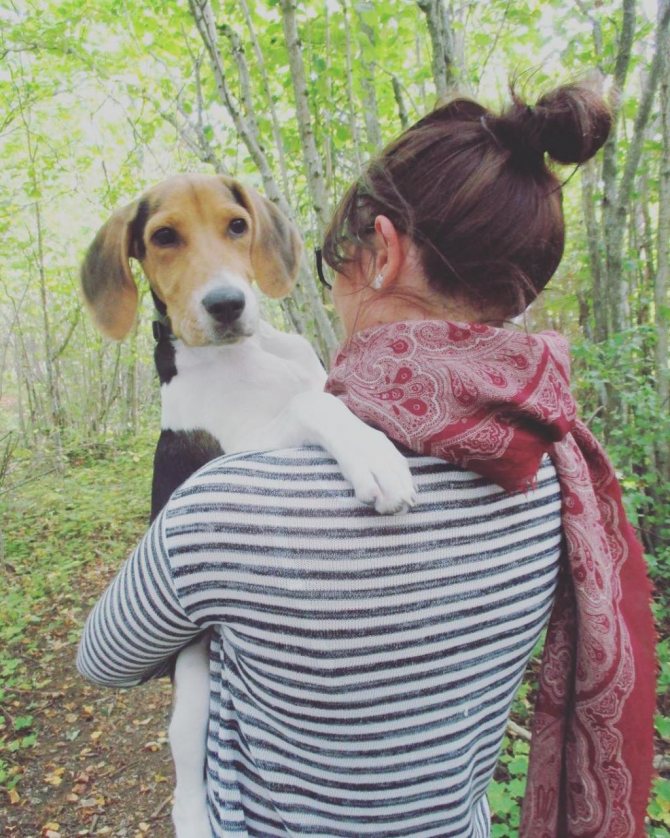
A professional hunter, uncompromising and merciless in the process of baiting the animal, the Estonian hound shows incredible friendliness towards its owners. She leaves her malice and assertiveness outside the threshold of the house, but within its walls she demonstrates an affectionate disposition, complaisance, devotion, patience, and obedience. The good-natured nature of this dog allows it to be kept in a family where children are growing up, as it shows amazing tolerance towards their pranks. Actually, the Estonian hound perceives a family as a pack, where the owner is the leader - she obeys him unquestioningly.
The Estonian hound will live in friendship and harmony with other pets if it grew up with them. If you take an adult dog into your home, you will have to make a lot of effort to eliminate the conflicts that will inevitably arise between four-legged household members, especially if the hound has to get acquainted with a representative of the cat tribe. It is advisable that the owner directly takes charge of establishing friendly relations between the four-legged animals.
A country house is the best place to keep an Estonian hound, but she can also feel quite comfortable in a city apartment if she is given the opportunity to expend her vigorous energy. Otherwise, this dog is unpretentious, and it is also surprisingly clean.
As for hunting, the Estonian hound is quite capable of starting to “work in his specialty” already at six months of age, and some especially talented individuals already at 7-8 months become holders of diplomas received based on the results shown during field tests. When hunting, they pick up a scent very quickly and are able to not miss it for three whole days, or even more. The excitement and aggressiveness shown during work allow these dogs to obtain enviable trophies. Nimbleness, dexterity, and also small stature – these are their advantages in the forest; they quickly and confidently climb through bushes or into dead wood where game is hiding, without giving it a chance to escape.
Despite the fact that the Estonian hound was bred as a hunting dog, thanks to its courage, alertness and intelligence, it also performs excellent guard functions.
Advantages of the breed
Representatives of this breed have a good sense of smell. They are very persistent and in a short time can find an animal and pursue it for a long time, unraveling its tricks. Estonians are able to keep an animal on the trail for up to three days! This gambling hunter has a beautiful, sonorous voice.
If a dog is trained correctly from early childhood, then from 5-7 months they begin to work. Thanks to its hunting qualities, the Estonian hound quickly established itself in the Soviet Union as a whole. This is an efficient and obedient dog, always responsive to its owner.
Its small stature is an excellent advantage in hunting in the forest; they run without interference under the spruce forest and penetrate into the dead wood, where the animal often hides. Now it is most often used in hunting hares and foxes, although it also hunts roe deer and wild boar. At the same time, the viciousness that she shows at the sight of potential prey does not manifest itself in relationships with people.
At home she is calm and balanced. This is an excellent companion for a mobile, active person who is able to provide the dog with high physical activity. Under such conditions, the Estonian hound can be kept even in a city apartment. Although the dog is best suited for living outside the city, where it can run a lot.
Education and training
The contact and quick-witted Estonian hound is quite easy to train - it grasps all commands on the fly. In addition to standard commands like “Sit!”, “Lie down,” “Give me your paw!”, she must certainly respond to the words “No!”, “Near!” This dog should not be pampered - it will certainly strive to take an independent position, and it will be difficult to wean it from habits such as lying in its owner’s bed and begging. A dog should know its place in the house, but brutal methods in raising it are unacceptable.
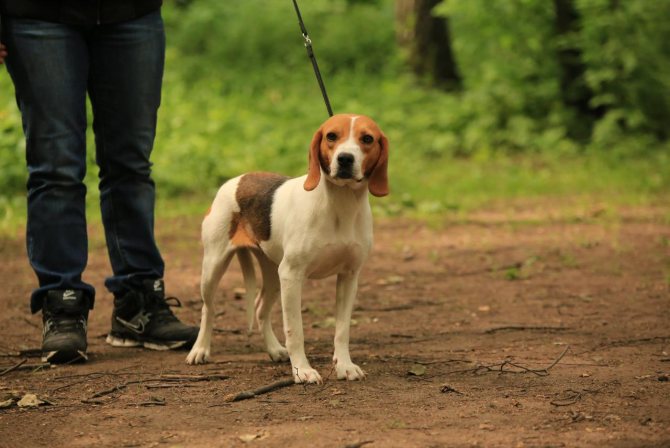
Estonian hound on a leash
The future hunter needs to be taught specific skills from puppyhood. Before feeding your pet, sound the hunting horn. As soon as he appears, feed him - this way he will develop a reaction to this calling sound.
If you prepare an Estonian hound puppy for hunting from a tender age, then from the age of seven months he will be able to start working. But experienced owners of dogs of this breed take into account that their childhood is short, and they always approach training with caution - preparing the pet to crawl correctly, detect the animal, drive it away without losing the trail. If you can simply take a two-month-old puppy into the forest with you for familiarization purposes, then a five-month-old dog can already be taught to navigate the terrain and maintain contact with the owner, who may be far from her. Training should be carried out systematically, commands should be practiced sequentially - from simple to complex, lessons should be repeated regularly, reinforcing the desired skills in the animal. During training, it is necessary to monitor the dog: if he is tired, the training should be stopped. Never use rude shouts if the dog is afraid to go into the forest. It is better to start the race with the black trail - this is the name of the autumn land that has not yet had time to be covered with snow.
Attentive, responsible owners do not allow a dog whose age does not exceed one year to work at full capacity, as this can negatively affect its health, especially the functioning of the heart. The Estonian hound can experience full stress when it is 1.5-2 years old.
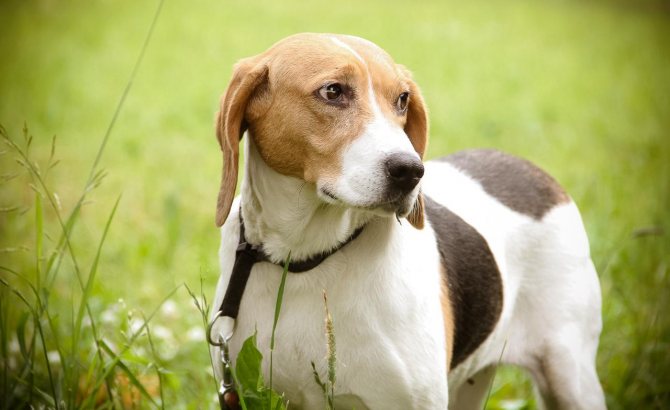
What is hound racing?
Training is the preparation of a hound dog for the hunt. The productivity of the dog depends on proper training. Hunting with a properly trained hound is a real pleasure. But incorrect training can ruin even the best dog. Therefore, it is not recommended for a beginner to catch up with the dog on his own.
Of course, for those who got a dog for pleasure, training is an optional event. But for those who plan to engage in sport or amateur hunting with a dog, the hunt is the first thing to take care of.
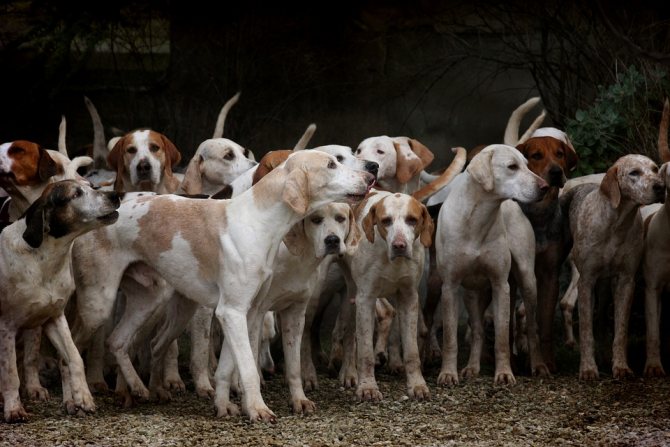
Hunting dogs need training
What innate and acquired qualities are valued in hounds?
First of all, flair or smell. Dogs with a good sense of smell are called “sensitive”, they can be seen immediately by the way they chase a hare: such hounds are skilled, that is, they rarely break off (loss of track, including due to the animal entangling the pursuer), and the rut is passionate, assertive and productive even in bad conditions. It is known that only 10% of hounds can easily “untangle” the trail of a cunning hare, and 15% are unsuitable for hunting due to a weak sense of smell.
V.V. Lukanichev in his “Wonderful Song of the Rut” talked about the importance of a hound’s sense of smell using the example of several dogs. You can distinguish the survivor (male) Bek and the survivor (female) Veika. The first one did not have good instincts and, although he was well overtaken, he constantly fell off the scent. And the second was able, in the most unfavorable conditions - in dry air and frost - to kill as many as seven birds with one stone in a few hours. “Without chipping, like a thread behind a needle,” according to the author, Veika stuck to the trail where other dogs got lost.
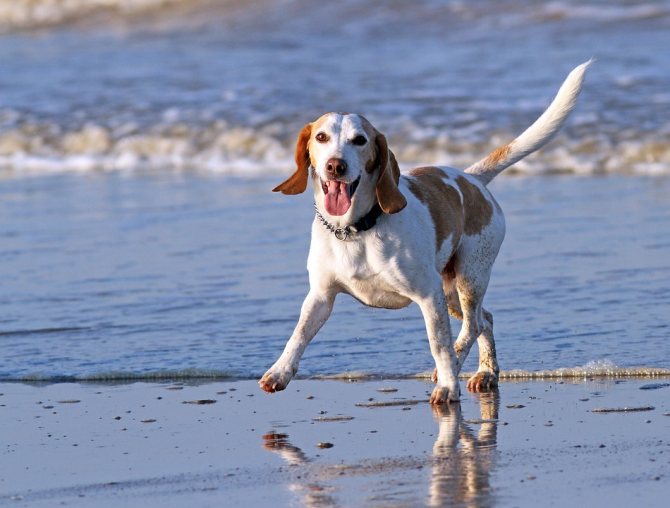
Flair is one of the most important senses of a hound.
Other important qualities:
- Resilience (endurance) - develops from puppyhood through long forest walks and training. It allows you to drive the animal at a good pace for a long time without getting tired.
- Paraty (speed) is directly related to instability. Innate quality: the straighter the legs, the more paratha the hound.
- Voice is an innate quality. The dog makes its voice during the rut in order not only to scare the animal, but also to let the hunter know where it is. A clear, melodious bark that can be heard for kilometers in the forest allows an experienced racer to determine the smallest details of the rut: who is being driven, where, and at what stage the rut is.
- Viscosity depends on the dog's experience, but is an innate quality. This is the ability to hold the rut for a long time without losing track under the influence of external circumstances. Another name for perseverance.
- Malice towards the beast is an innate quality, expressed in the readiness to drive the “red beast” - the wolf and the fox. Especially the vicious and fearless ones raise boars and lynxes.
- Crawl, or search for an animal before the start of the rut. Developed through training, one of the key skills. The width (the ability to cover a large area when searching) of the crawler and at the same time the ability to lead the search movement behind the hunter are valued.
- Calling is the ability of a hound to come when called. Some particularly sticky dogs may ignore the call; this is not encouraged. Quality is instilled from puppyhood; dogs are often taught to come to the sound of a horn.
- Politeness is treating pets and other dogs well.
- Roughness is important for hunting in a pack. This is the ability of all dogs to start rutting at once upon a signal from one individual who has found the trail.
- Obedience - develops from puppyhood with the help of training. Very important for dog safety and productive hunting.
- Moreover, in a situation where the dog is left alone with the animal, it must make the right decision itself. Flair, skill and, of course, experience help with this.
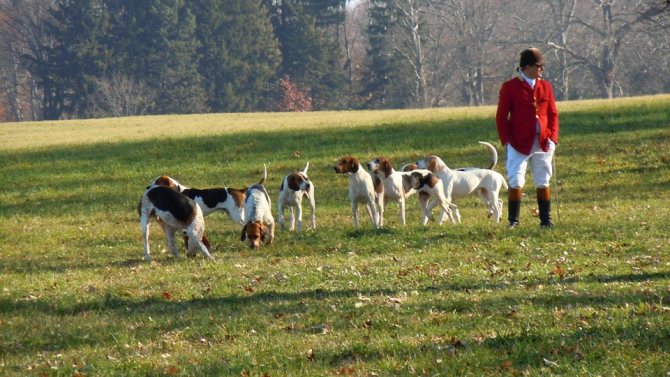
Hounds have important innate and developed qualities.
Some especially instinctive, quick-witted and skilled hounds manage to drive away a hare - to catch and strangle it on their own. A driven hare differs from a shot one in that its body seems to be frozen and bends with difficulty.
Care and maintenance
The Estonian hound does not take up much space in the house, and, despite its mobility, it is not prone to destructive actions. Since this breed is characterized by an almost complete absence of undercoat, and the hair itself is short, the owners are spared the need to scrupulously care for the animal’s coat. True, it is advisable to comb the dog more often, even daily. The procedure is carried out using a special comb for dogs with short, coarse hair. Estonian hounds do not need frequent bathing, unless you take into account, of course, the hunting season. They can be washed once a month, and in the summer, an alternative to bathing in a bathtub or basin can be swimming in the river, which these frisky dogs will be very happy about.

5 month old Estonian hound puppy
An Estonian hound living in a city apartment needs long walks. She will be happy to go for a walk with her owner, or become his companion on a cycling track or a morning jog. By the way, despite the fact that these dogs are very active, they are not inclined to run and jump tirelessly, not giving rest to those around them.
You should walk your pet at least twice a day, and ideally this should be done four times: early in the morning, during the day, in the evening and before bed. In total, it is advisable for the dog to cover 4-5 km per day, and it must be given the opportunity to move at different speeds. A dog living in the city needs to run without a leash at least once a day so that he can throw out excess energy. However, it is dangerous to let Estonian hounds off the leash near roads and roadways: if they are interested in the track of any animal, they, driven by instinct, may stop paying attention to what is happening around them, risking being run over by a car.
The Estonian hound is not too picky when it comes to food, but owners should not take advantage of this quality. It must be taken into account that its food should be more filling and high-calorie than the food usual for dogs that are not hunting breeds. Both natural food and dry food are suitable for your pet. An adult dog should be fed twice a day - morning and evening. It is advisable that the food is slightly warmed up. It is better not to offer chicken and large beef and pork bones to the dog at all, but he needs raw lean meat. Treat your pet to raw fish; flounder is a good option. Don’t forget about vegetables, these vitamin-rich foods are simply necessary in the animal’s diet. Carrots are especially useful for your pet; they can be grated and combined with minced meat. Once a week you can add some raw or boiled potatoes to your menu. The preferred cereals are barley, pearl barley, and oatmeal. Millet can be given only occasionally.
Fermented milk products of low or medium fat content are also beneficial for animals. Make sure there is always water in the dog's bowl, especially in hot weather.
Nutritional Features
Estonian hounds will ride whatever is offered to them. If the dog is not limited in the amount of food, he will overeat and gain weight. When the owner cannot devote enough time to preparing food for the dog, preference should be given to ready-made food. When choosing this type of feeding, you must strictly follow the dosage indicated on the package. As a rule, manufacturers indicate the serving size depending on the weight, age and breed of the animal.
An adult dog is fed 2 times a day, puppies up to 6 months old need to be offered food 5-6 times a day. Food should be given at the same time every day. Basic rules of Estonian nutrition:
- The dog's food should be slightly warmed;
- Feeding bowls must be placed on special stands with adjustable height;
- uneaten food must be removed, offering the rest of the portion next time.
When eating natural foods, you should include the following products in your menu:
- Lean meat. For puppies up to one year old, the food is boiled a little or poured over with boiling water. Adult pets are given raw meat.
- Sea fish. Before serving, seafood is deboned. Fish should be offered no more than once every 7 days.
- Vegetables (carrots, beets, zucchini, in limited quantities - potatoes and herbs). Products can be given raw or boiled.
- Cereals. It is preferable to give the dog barley, barley, and oatmeal. For adult dogs, cereals are given steamed; for puppies, they are boiled in water or light meat broth.
- Cottage cheese, kefir, fermented baked milk. For dogs up to 6 months old, kefir can be mixed with porridge.
- Boiled eggs. The product should not be abused. An adult dog is offered an egg no more than once a week.
Estonian hounds are contraindicated:
- tubular bones;
- pork;
- dishes from the host's table;
- spicy, smoked, salty foods;
- spices;
- flour and pasta products;
- sweets.
Health and diseases of Estonian hounds
The Estonian Hound belongs to the category of dogs that have a strong immune system and are rarely susceptible to diseases. They live up to 10-14 years. Among the most common diseases that are characteristic of this breed are arthritis, dislocations, ligament ruptures that occur as a result of physical stress experienced during hunting, as well as otitis media - inflammatory processes in the ears, often developing in dogs with floppy ears.
Ticks that carry piroplasmosis pose a serious danger to Estonian hounds working in the forest. After the hunt, the owner needs to examine and feel the animal, and at the first signs of the dog’s discomfort (sadness, refusal to eat, thirst, pale mucous membranes) immediately contact a veterinary clinic.
How to choose a puppy
The Estonian hound is not a very popular breed in the Russian Federation. These dogs are not very recognizable, so unscrupulous sellers often sell puppies of unknown breeds under the name of the Estonian Hound. Often, dogs purchased second-hand at a poultry market do not even remotely resemble this breed in their appearance.
You should go to a nursery to pick up a puppy, where you need to carefully read its pedigree. If you are going to raise a real hunter from your child, make sure that his parents were not peaceful apartment dwellers, but seasoned hunters - holders of diplomas received after passing field tests. A puppy whose parents have not hunted a single hare is unlikely to have well-developed hunting instincts.
When choosing a baby, examine him, paying attention to the fact that he should not have an underbite or bulldog, which manifests itself in the fact that the lower jaw is longer than the upper. Your chosen one's eyes should be as dark as possible. The dog should be active, look like a real tough dog - powerful, bony, thick-footed.
Find out about the age of the prospective pet's mother. If she is less than one and a half years old or more than nine years old, there is a high chance that the puppy may grow up with developmental disabilities.
There is also the option of purchasing an Estonian hound puppy from a professional hunter who has knowledgeably bred his own dog and is willing to share its offspring. Please note, however, that he will probably keep the best heir to his bitch for himself.
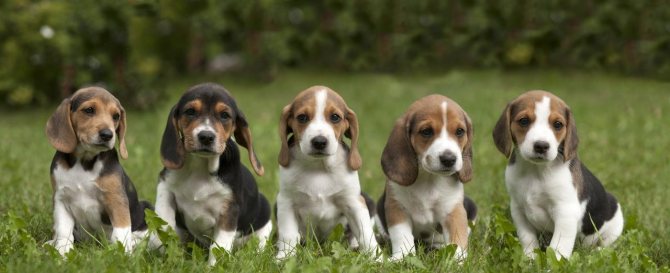
Photos of Estonian hound puppies
With a young hound
WITH A YOUNG HUNCH
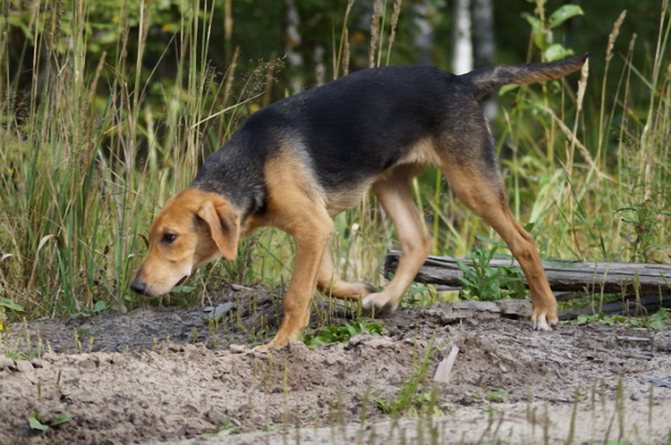
N.P. Kishensky in his book “Rifle Hunting with Hounds” wrote: “No other breed of hunting dog requires so much skill and skill in this regard; All of them, except the hounds, are placed in more comfortable living conditions by custom and nature, and yet it is from the hounds that the qualities of other breeds are required in the aggregate. What is really required of hounds? - Iron legs and strength, therefore, the quality of racing dogs, anger - the quality of baiting dogs, the finest instinct and politeness - the quality of cops. Take away any of these qualities and the hound is no good.”
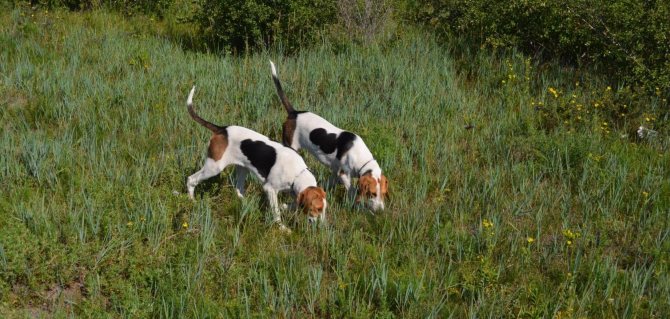
If cops and some other breeds are kept in a room, then the hound, this “real soul of the hunt,” often lies on an armful of straw in a small shed even in severe frost. Many of them die and disappear during the hunt. Often a young dog, let loose, will suddenly awaken the fox and go away without hearing. Not every one of them will return to the owner, and sometimes even worse - they end up in the sharp teeth of a wolf. Young hounds also disappear due to incorrect, inept training. Often during field trials and hunting we see dogs that are completely unaccustomed to either the horn or the call. The simplest rules of training and conditioning are not followed - this causes significant damage to the breed. Before going into the forest with a young hound, the dog must be accustomed to the horn, walking freely in the fold, following the commands “stand”, “come to me”, and so on. Without mastering all these rules, a hound released into the forest becomes uncontrollable. It is not difficult to accustom a puppy to a collar. To do this, first put on a light collar, then replace it with a wide one and lead it on the puppy, stroking, encouraging and giving a treat. Under no circumstances should you hit a stubborn dog. In extreme cases, it is better to put it on a chain, and when it gets tired, lead it on a chain. Gradually the dog will submit, and success is certainly guaranteed.
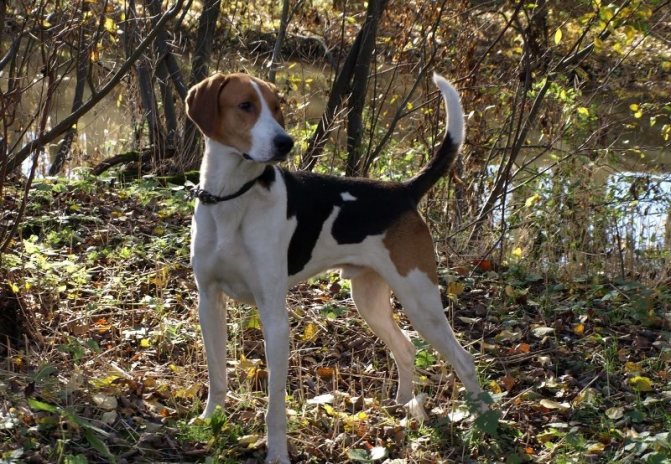
From the age of three months they begin to accustom the hound to the horn. Before feeding, each time the “call” is blown on the same horn, so that, having remembered the tune, the hound, when hunting and chasing, will fall only on its own horn and not go to someone else’s. The commands “stand” and “open” are taught before feeding. It is necessary to ensure that the dog throws the food at the command “discover”. Then, when hunting, you can safely take the killed animal. The command “stand” is needed to take the dog at the right time during the hunt. In our conditions, following commands is especially important. The claim that this supposedly reduces viscosity is without any basis. The oldest cynologist expert, “the father of Russian hounds” N.P. Pakhomov wrote in his book “Field Tests of Hounds”: “It’s not the stance that kills the passion in a pointer; after takeoff, the pointer is forced to overcome the completely instinctive need within her to rush after the one that has flown away.” a bird..." Further, N.P. Pakhomov pointed out that failure to follow the rules is simply the reluctance of some "...lazy hunters to spend time accustoming a young hound to the unwise demands of politeness and urge. Hound training is needed. It can make hunting a pleasant holiday, only it can make hunting a game of prey, and not an accidental one.” An important requirement is the hounds’ calm attitude towards pets. They need to be taught this from puppyhood, especially those who are too angry and raised in the city. The easiest way is to lead the dog to birds or livestock in a pack, and patiently teach it to indifference by pulling back or punishing it. If you do not immediately train a hound and it manages to kill a domestic animal, it is almost impossible to wean such a dog later.

After the hound has mastered all the commands, it is taken to the race. Correct training can enhance the important qualities of a dog: crawling, prey, but inept training sometimes spoils the dog forever or leads to its loss. Recently, in many areas, hounds are dying from wolves, of which there are so many that hunting with a hound in the snow is extremely dangerous. The old people, in order to protect the dog from the attack of the gray robber, tied a bell around its neck on a rawhide strap. In the center, the strap was made slightly wider than the ear of the bell (so that it would not jump off), and the ends of the strap were made thin. If the hound gets caught on a branch, the strap should break. The hounds were trained to wear bells in advance of the hunt. The wolves did not touch dogs with bells. A young dog is taken into training as a ten-month-old puppy. But, as our experienced racers V.I. Kazansky and D. Fedorin recommended, you can start earlier, depending on physical development. You can introduce a hound puppy to the forest from the age of four months. But we must not forget that real training, when a dog works in the field for 4-5 hours every other day or two, is different from an hour-long walk in the forest. If a six-month-old puppy is given the opportunity to frequently chase the animal for 4-5 hours, including searching and rutting, the dog can be “set on its feet.” I remember the first time I trained a five-month-old Russian pinto hound, Skripka. The dog was viscous, but after 30-40 minutes of the rut it lay down, and after catching its breath, it began again. I ruined the dog. Then I began to drive and train the hounds, listening to the advice of the hounds and, of course, I made a lot of mistakes. The trouble is that the young “unfeeling” hunter follows all kinds of advice indiscriminately. And many, even experienced racers, take puppies hunting - let them get used to it, they say. I remember how the old Moscow hound expert V.Kh. Braushkin took the eight-month-old Russian pinto hound Volga on a hunt and paired her with the autumn-haired survivor Malysh. The Volga turned out to be so viscous that in the evening she was often taken out of the rut and more than once carried in her arms to the village. She couldn't walk on her own. She grew up very weak, and at the exhibition it was a stretch to get “good”. The rule for all hounds is one - do not delay, but involve the dog in the work, taking into account all the conditions.
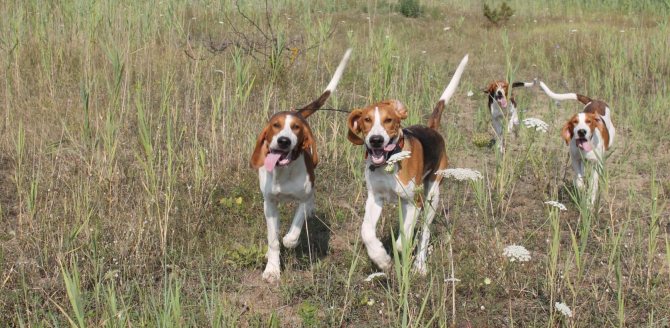
The first theorist of gun hunting with hounds, N.P. Kishensky, wrote about this in the book “Rifle Hunting with a Hound”: “I already had to say that before the age of one year, hounds should not be used for real hunting, and many people get carried away with this and spoil the dogs.” . However, he did not exclude the possibility of training 8-9-month-old puppies, because there cannot be a general and unmistakable rule regarding the beginning of training. But a late start to the hunt is better than an early one, and if you value hounds, it is better to be a few weeks late. N.P. Pakhomov shares the same opinion.
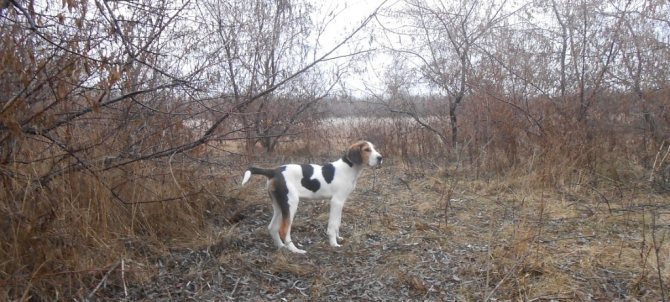
Most hound owners are in favor of introducing the hound to the forest from an early age, and immediately it needs to be weaned from approaching strangers. This is an important and main condition, otherwise you can lose a young dog. It is better to attack a hare in the spring. Autumn is a difficult time for young hounds - the leaves fly away, and it is not easy to motivate the animal. In the spring, the white hare does not sink as much as in the fall during molting, it circles smoothly and is almost always audible. Therefore, it is easier for the handler to help the dog during the chipping. The fox often takes her out of hearing, sometimes for many kilometers, and this animal is cautious - just where you make some noise and “remember what they were called” - then look for the wind in the field. The old testament of experienced hounds is that a tough hunter has a tough dog. Never leave the dog and chase several birds with one stone in one morning - this only spoils the dog. On this occasion, N.P. Pakhomov wrote in the book “Hounds and Hunting with Them”: “Some hunters in areas where there are many hares often give up after killing to look for the lost animal and begin to look for another. As a result, the hound also learns to abandon one animal and goes in search of the next. The young hound must be forced to sort out the tracks after the chip until she picks up the hare again. Only such a hound will be successful and pleasant.” The special vein of the racer brings the hunter into the highest tension; there is nothing sweeter than listening to the flooding rut. And whoever has known this passion at least once is forever connected by blood with the hounds. It’s not for nothing that in the old days, during the bright rut, the hunters started dancing and took off their hats - “it’s a flock roaring on the island” - “what’s your Rossini, what’s your Beethoven!”
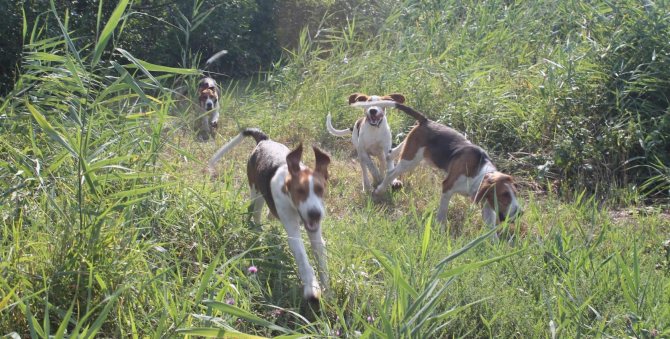
The hound is released where the hare is kept. The trouble is, if you come across a “running” animal, it can immediately “ask straight” and take the dog away from hearing. Before unleashing, do not forget that the hound is standing without a collar. Usually a young dog that is allowed to crawl does not go far. In order to have constant contact with her, and also to more easily motivate the beast, enchanting sounds of squealing have come down to us from ancient times - cheerful cries: get it, get it, here it is, scythe, come on, come on, dear, get it, so, so, and -la, a-oh! You should always puff in the same manner. Hounds have an amazing memory and get used to the voice of their owner. I remember the first time I learned such a loud flapping from an experienced racer and expert A.K. Lidum. He walked slowly in the forest and always had sweets for the dogs in his pocket. If the hounds did not show up for a long time, he would stop and cheerfully shout: “Come on, Yuga, get it, get it, Gulik, aay!” Through such contact, he developed an independent, intelligent and wide crawl among the hounds.
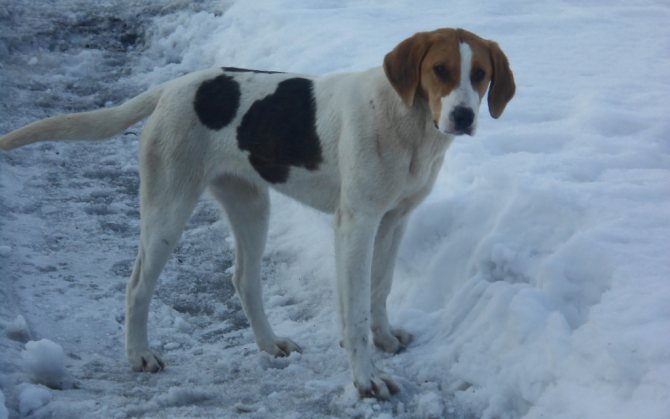
A lot has been written about the race, but to this day there are still controversial areas. For example, what is the best way to train a young dog - alone or with an old dog? The fact is that there are both positive and negative sides to this issue. There are much more of the latter. Why? First, the young hound in a pair learns to work, relying on the other hound. Secondly, usually experienced messengers, having a wide range and knowledge of the area, take the hound that first gets into the forest so far that it often does not return to its owner. Thirdly, an old hound may also have negative qualities - weak-voiced, uncooperative, rutting at the heel, and the like. A young hound immediately takes on these qualities. The famous dog handler and expert N. N. Chelishchev wrote in a short guide for young hunters: “Strange as it may seem, young people are more willing to adopt vices from old (hounds) than virtues, and this circumstance must be especially borne in mind when choosing old dogs for hunting " Experienced hound owners know: if you take a young hound to race with an experienced dog once, then go ten times to train the young hound for independent hard work alone. If a young hound comes from working dogs and was raised in freedom with good feeding, it should begin to work on its own. By training alone, it can be developed into an efficient working dog, which later, out of necessity, will always work in pairs. The most decisive and important thing in training is the development of skill and consistency - never take the dog away from the kill and look for another hare, do not leave the hound alone in the forest, do not engage in extraneous activities - picking mushrooms, replacing and shooting hazel grouse, and so on. In order to help his hound at the kill, the hunter must have a certain skill, know the habits of the animal, understand discounts and loops. Make a circle with the dog, small at first, and then expand the circles, encouraging the dog by squealing. It is advisable to notice where the dog has lost its track (fell silent), because the hare's mark, as a rule, is located somewhat behind the place where the hound fell silent. It is very important.
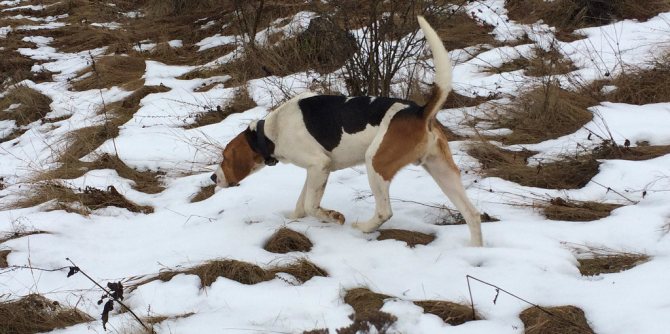
Viscosity - persistence in pursuit of the beast, a hereditary quality of the hound. However, there are hounds that are so weak that chasing and hunting with them is just punishment, and nothing can instill this important quality in them.
Very often, young dogs vocalize at fat marks and even vocalize at birds. Over time, when the hound chases the hare once or twice, it stops crying in vain. If the dog digs too much in the fatty marks and gives a voice, the hunter is obliged to take it and lead it away. Often there is an additional call - the return of a voice when the animal has not yet risen from its bed. The property is often inherited and no amount of effort can correct this. Picking a hare is a vice, because while the hound is wailing, the animal rises from its bed and “throws so many twos at it” that it “mumbles” through the forest for a long time and languidly. There are hounds that cry in vain. We need to get rid of weak-voiced hounds, because this is a defect that nothing can correct. When chasing, skillfully use the horn and stick. The main rule is never deceive dogs. Calling is necessary when the hunter has seen the animal and wants to “put” the dog on the scent, and not when he needs to take it to the hunt. They blow a horn to “take down” the dog. When leaving home to catch up, you can and should sound the trumpet. Young hounds immediately remember these sounds. When the hounds hit the horn well, the hunter is simply obliged to give a treat. However, many people do not follow this rule, and sometimes, for unknown reasons, they even punish the dog, saying that it is unlucky, hanging out somewhere, or even worse, they blow the horn endlessly. In this case, the hounds stop coming to the horn altogether. During field trials you often see how the owner (leader) cannot guide the hound to the scent of a hare. In this case, the click must be used energetically and skillfully. Old experienced racers call like this: here, here, here, a-la, ala, a-la - it seems that the forest is trembling. However, when hunting, especially fox, it is better to instruct the dog by calling the horn, observing the necessary silence and caution. There is only one rule - both during hunting and chasing, you need to make less noise, not frighten the animal, and call or blow the horn only when absolutely necessary. When training a dog, you need to keep it in working body, that is, so that the hound is not too fat. Under no circumstances should you take hounds for training after an illness, especially distemper; a break of several months is necessary. Making a hound dog tough, skillful, and polite is a difficult task, requiring skill, patience, and most importantly, a fierce love for dogs, for the forest, for the rut. Nothing is easier than spoiling the best of hounds with what would seem to be the most innocent of incidents. Therefore, in addition to the training rules listed above, a young racer must adhere to the following:
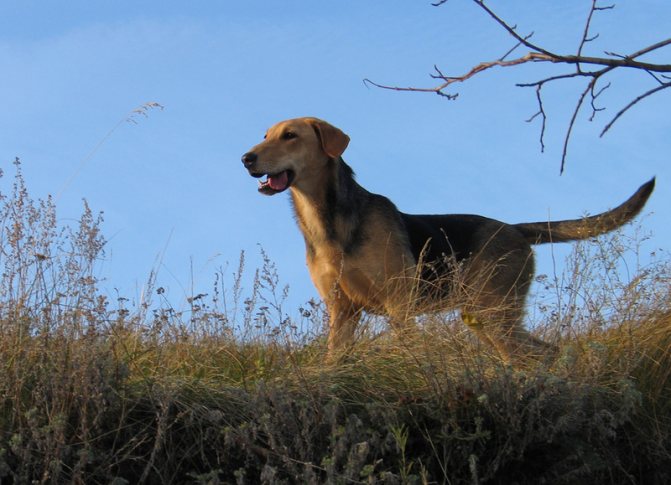
➡ never chase a young hound with powder, as the dog gets used to chasing only “by eye”.
➡ do not scold at night, this scolding spoils the dogs, as the hound gets used to chasing several birds with one stone;
➡ when training, do not forget to give the command “stand” and give a treat when the hound follows the commands of the owner-driver.
➡ never hit a dog, only with an even and affectionate attitude can you gain its trust.
➡ do not go to the race with a large group.
➡ always remember that the main quality of hounds is instinct. Incorrect maintenance and feeding can ruin it and no amount of training can restore it.
➡ train your hound to race in any weather, in any conditions - in a swamp, small forest, and so on.
How much does an Estonian hound cost?
If you are purchasing an Estonian hound as a pet and do not intend to make full use of its hunting qualities, you can respond to advertisements on the Internet and purchase a dog for 5,000 rubles. However, ask the seller to give you the opportunity to find out what the puppy's mother looks like. Please also note that in this case you will most likely have to do the vaccination of the animal yourself.
An Estonian hound puppy from a kennel, whose parents were famous hunters, will cost up to 30,000 rubles.
